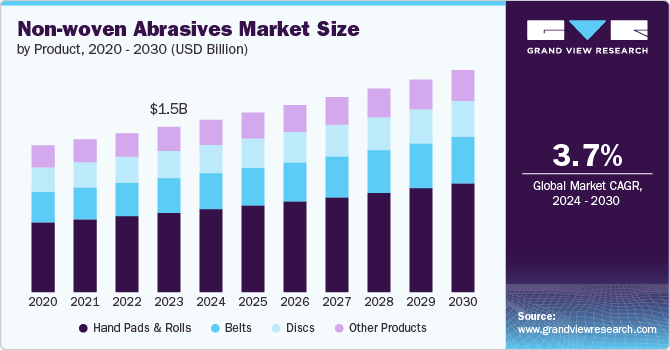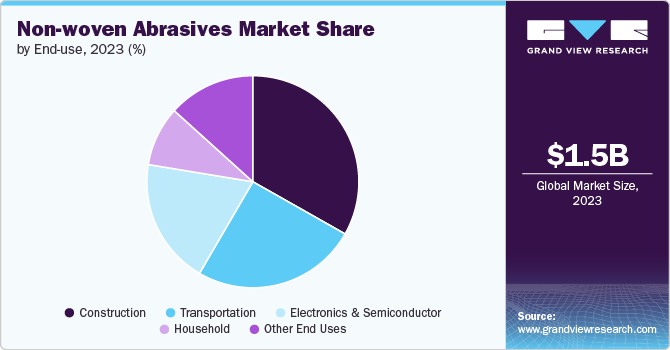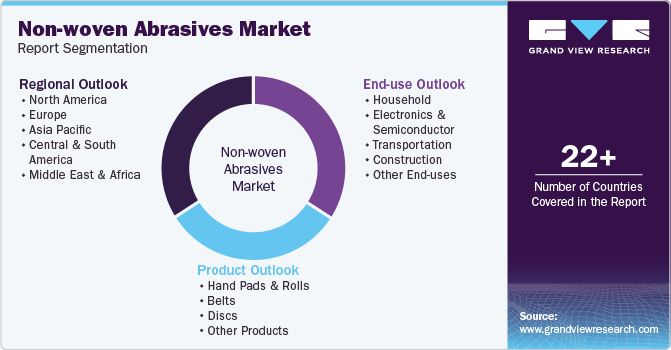- Home
- »
- Advanced Interior Materials
- »
-
Non-woven Abrasives Market Size And Share Report, 2030GVR Report cover
![Non-woven Abrasives Market Size, Share & Trends Report]()
Non-woven Abrasives Market Size, Share & Trends Analysis Report By Product (Hand Pads & Rolls, Belts, Discs), By End Use (Household, Electronics & Semiconductor), By Region, And Segment Forecasts, 2024 - 2030
- Report ID: GVR-4-68040-460-5
- Number of Report Pages: 109
- Format: PDF, Horizon Databook
- Historical Range: 2018 - 2022
- Forecast Period: 2024 - 2030
- Industry: Advanced Materials
Non-woven Abrasives Market Size & Trends
The global non-woven abrasives market size was estimated at USD 1.54 billion in 2023 and is forecasted to grow at a CAGR of 3.7% over the forecast period. This growth is attributed to the increasing requirement for superior surface finishes in various industries such as automotive, aerospace, and electronics. Non-woven abrasives, known for their ability to provide consistent surface finishing without excessive material removal, are gaining preference for applications like paint preparation, polishing, and deburring in these industries.

The metalworking industry is a major consumer of non-woven abrasives, which are used for tasks such as deburring, surface preparation, and polishing. The flexible nature of non-woven abrasives, which conforms to complex surfaces, makes them essential in sectors like aerospace, automotive, and shipbuilding, where high precision is crucial. As industries push for higher-quality finishes, this is expected to increase product demand.
Non-woven abrasives are becoming more popular for household applications like cleaning, polishing, and light surface finishing. The rise in DIY home projects during the pandemic has further boosted demand in the household sector. Furthermore, non-woven abrasives are often more sustainable than other abrasive products because they can be washed and reused multiple times, reducing waste. Industries looking to adopt environmentally friendly practices see non-woven abrasives as a viable alternative to single-use products.
Although non-woven abrasives are ideal for surface finishing and polishing, they are generally less aggressive than traditional bonded abrasives. In applications requiring significant material removal, such as heavy industrial grinding, they may not be as effective, which can restrict their use in certain sectors. In addition to this, non-woven abrasives tend to be more expensive than conventional abrasives like sandpaper. This higher cost can be a limiting factor for industries with tight budget constraints, particularly for large-scale operations where abrasives are used in bulk.
Innovations in the composition and structure of non-woven abrasives are creating opportunities for more durable and efficient products. These innovations can help bridge the performance gap between non-woven and traditional abrasives, especially in heavy-duty applications. Furthermore, with the rise of automation in industries, there is a growing demand for abrasive materials compatible with high-efficiency automated systems. Non-woven abrasives, which offer consistent performance in automated systems, are poised to benefit from this trend.
Product Insights
Based on product, market is segmented into hand pads & rolls, belts, and discs. Hand pads & rolls dominated the market with a revenue share of 48.0% in 2023 and are further expected to grow fastest over the forecast period. These are widely used for manual finishing and cleaning applications, especially in industries like household and electronics. Furthermore, these are designed primarily for manual applications, offering flexibility and convenience in reaching hard-to-access areas. In addition, hand pads and rolls provide cost-efficiency and versatility, making them widely adopted in industries where precision finishing and light surface modification are needed.
Non-woven belts are used primarily in heavy-duty applications. These products are designed for belt sanders and other industrial machinery, making them ideal for automated processes requiring continuous and efficient surface conditioning. They are built to withstand high friction and heat, making them suitable for demanding applications like metal finishing. Moreover, despite being machine-operated, non-woven belts retain some flexibility, allowing them to conform to complex shapes and contours, similar to hand pads but on a much larger scale, which is expected to drive its growth.
End-use Insights
Based on end use, the market is segmented into household, electronics & semiconductor, transportation, and construction. Among these, construction end use accounted for the largest revenue share of 33.2% in 2023 and is expected to grow fastest over the forecast period. In construction sector, non-woven abrasives are employed in various applications, from surface preparation to maintenance and repair. The robust nature of these abrasives makes them ideal for handling heavy-duty materials such as steel, concrete, and stone. Furthermore, with increasing demand for sustainable and aesthetically pleasing construction materials, construction industry is expected to drive further demand for non-woven abrasives, especially in applications involving new materials like engineered stone and composite metals.

In the transportation industry, non-woven abrasives are used throughout the manufacturing and maintenance processes to ensure the durability, functionality, and aesthetic finish of vehicles and transportation components. The rising demand for electric vehicles (EVs) and advancements in aerospace technology are expected to drive the use of non-woven abrasives in transportation. Furthermore, with need for lightweight and high-performance materials that require precision finishing, non-woven abrasives will continue to be a valuable tool in this industry.
Regional Insights
The non-woven abrasives market in North America accounted for a revenue share of 27.9% in 2023 and is further expected to grow at a fastest rate of 3.8% over the forecast period. The metal fabrication industry is robust across North America, and non-woven abrasives are heavily used in surface preparation, polishing, and finishing tasks. Therefore, with increasing investments in infrastructure and construction, the demand for these abrasives is set to rise in North America.
U.S. Non-woven Abrasives Market Trends
The non-woven abrasives market in the U.S. is growing significantly over the forecast period because well-established industries utilize these abrasives in various applications, from metalworking to construction. Furthermore,automotive and aerospace industries in the U.S. are also major consumers of non-woven abrasives.
Europe Non-woven Abrasives Market Trends
The non-woven abrasives market in Europe is growing steadily, driven by the region's focus on manufacturing excellence, high-quality surface finishing, and sustainability efforts. Furthermore, the region has strict environmental sustainability and waste reduction regulations. Non-woven reusable abrasives that produce less waste are increasingly in demand, particularly in the metalworking and construction industries.
Asia Pacific Non-woven Abrasives Market Trends
Asia Pacific dominated the non-woven abrasives market in 2023 with a revenue share of 36.6% and is further expected to grow significantly over the forecast period. This growth is driven by rapid industrialization, urbanization, and rising demand from various automotive, metalworking, and electronics industries. Countries such as China, India, and Japan are major hubs for manufacturing, particularly in automotive, aerospace, and electronics industries. The increasing production of vehicles, heavy machinery, and consumer electronics boost demand for non-woven abrasives in surface preparation, finishing, and polishing applications.
Key Non-woven Abrasives Company Insights
Some of the key players operating in the market are 3M and Saint-Gobain:
-
3M is a leading market player, primarily focusing on diversification of abrasives portfolio and providing a wide range of products to various industries. It emphasizes investment in R&D and more on sustainability, eco-friendly materials, and technologically advanced manufacturing processes that align with growing demand for environmentally conscious solutions.
-
Saint-Gobain is another leading market player competing by adopting a strategic approach to global expansion through mergers and acquisitions to acquire complementary businesses and strengthen its product offering portfolio. It invests heavily in R&D, focusing on the development of advanced abrasives technologies.
DWALT is one of the emerging participants in the market.
-
DEWALT was established in 1924 and is based in the U.S. This company has an extensive product range comprising various power tools, hand tools, and accessories. This range includes cordless drills, circular saws, angle grinders, jigsaws, sanders, planers, nailers, and staplers, as well as a comprehensive offering of hand tools such as pliers, wrenches, and screwdrivers. It offers a range of non-woven abrasives under its accessories section of the product portfolio.
-
Mirka Ltd. was established in 1943 and produces surface finishing technology serving solutions for surface finishing and precision sanding. Its range of products includes abrasives & compounds, power tools, robotics & automation, dust-free sanding, and accessories.
Key Non-woven Abrasives Companies:
The following are the leading companies in the non-woven abrasives market. These companies collectively hold the largest market share and dictate industry trends.
- 3M
- Saint-Gobain
- DEWALT
- Carborundum Universal Limited (CUMI)
- Sia Abrasives
- PFERD
- Mirka Ltd.
- TGA Abrasives
- Osborn
- Steel Shine
Recent Developments
- In October 2023, Saint-Gobain announced a partnership with Dedeco Abrasive Products, a specialty abrasives manufacturer, where Saint-Gobain would market Dedeco’s sunburst abrasive line. This partnership aligns with the company’s comprehensive goal of delivering abrasive solutions.
Non-woven Abrasives Market Report Scope
Report Attribute
Details
Market size value in 2024
USD 1.60 billion
Revenue forecast in 2030
USD 2.06 billion
Growth rate
CAGR of 3.7% from 2023 to 2030
Actual data
2018 - 2022
Forecast period
2024 - 2030
Quantitative units
Revenue in USD million/billion and CAGR from 2024 to 2030
Report coverage
Revenue forecast, competitive landscape, growth factors, and trends
Segments covered
Product, end use, region
Regional scope
North America; Europe; Asia Pacific; Central & South America; Middle East & Africa
Country scope
U.S.; Canada; Mexico; UK; Germany; France; Italy; Spain; China; India; Japan; South Korea; Brazil; Argentina
Key companies profiled
3M; Saint-Gobain; DEWALT; Carborundum Universal Limited (CUMI); Sia Abrasives; PFERD; Mirka Ltd.; TGA Abrasives; Osborn; Steel Shine
Customization scope
Free report customization (equivalent up to 8 analysts working days) with purchase. Addition or alteration to country, regional & segment scope.
Pricing and purchase options
Avail customized purchase options to meet your exact research needs. Explore purchase options
Global Non-woven Abrasives Market Report Segmentation
This report forecasts revenue growth at regional & country levels and provides an analysis of the industry trends in each of the segments from 2018 to 2030. For this study, Grand View Research has segmented the global non-woven abrasives market based on product, end use, and region:

-
Product Outlook (Revenue, USD Million, 2018 - 2030)
-
Hand Pads & Rolls
-
Belts
-
Discs
-
Other Products
-
-
End Use Outlook (Revenue, USD Million, 2018 - 2030)
-
Household
-
Electronics & Semiconductor
-
Transportation
-
Construction
-
Other End Uses
-
-
Regional Outlook (Revenue, USD Million, 2018 - 2030)
-
North America
-
U.S.
-
Canada
-
Mexico
-
-
Europe
-
Germany
-
UK
-
France
-
Italy
-
Spain
-
-
Asia Pacific
-
China
-
Japan
-
India
-
South Korea
-
-
Central & South America
-
Brazil
-
Argentina
-
-
Middle East & Africa
-
Frequently Asked Questions About This Report
b. The global non-woven abrasives market size was estimated at USD 1.54 billion in 2023 and is expected to reach USD 1.60 billion in 2024.
b. The global non-woven abrasives market is expected to grow at a compound annual growth rate (CAGR) of 3.7% from 2024 to 2030 to reach USD 2.06 billion by 2030.
b. Hand pads & rolls accounted for largest revenue share of 48% in 2023 and is further expected to grow at a fastest rate over forecast period on account of their wide use for manual finishing and cleaning applications, especially in industries like household and electronics.
b. Some key players operating in the non-woven abrasives market include 3M, Saint-Gobain, DEWALT, Carborundum Universal Limited (CUMI), Sia Abrasives, PFERD, Mirka Ltd., TGA Abrasives, Osborn, and Steel Shine.
b. The key factors that are driving the non-woven abrasives market growth is the increasing requirement of superior surface finishes in various industries such as automotive, aerospace, and electronics.
Share this report with your colleague or friend.
![gvr icn]()
NEED A CUSTOM REPORT?
We can customize every report - free of charge - including purchasing stand-alone sections or country-level reports, as well as offer affordable discounts for start-ups & universities. Contact us now
![Certified Icon]()
We are GDPR and CCPA compliant! Your transaction & personal information is safe and secure. For more details, please read our privacy policy.
We are committed towards customer satisfaction, and quality service.
"The quality of research they have done for us has been excellent."





